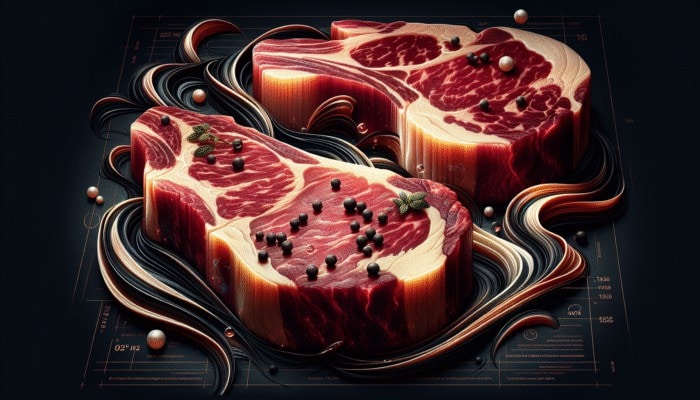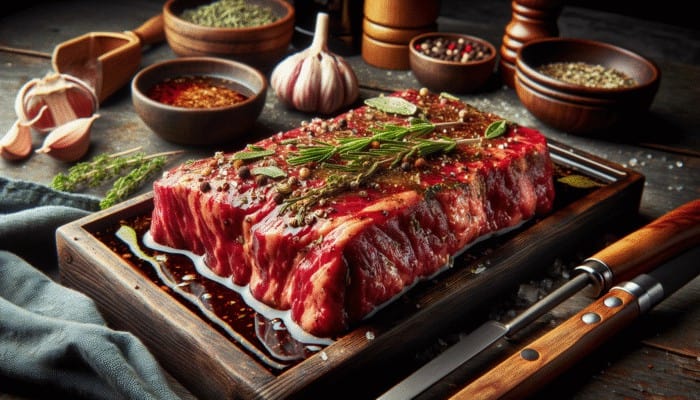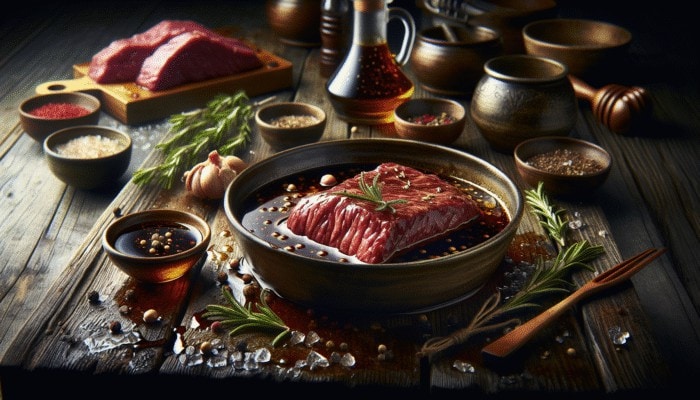Discover the Perfect Wagyu Cuts for an Unforgettable Grilling Experience
To truly master the art of grilling Wagyu beef, it is crucial to start with the right Wagyu cut. Understanding the various cuts available is key to refining your grilling skills and ensuring a remarkable culinary event. By familiarizing yourself with the different cuts and their unique grades, you can significantly elevate your grilling results. Wagyu beef, celebrated for its exceptional marbling and tenderness, can turn an ordinary meal into a spectacular feast that will leave a lasting impression on your guests long after they’ve savored their last bite.
Gain Insights into Wagyu Beef Grading for Optimal Selection

The USDA grading system is a vital tool for assessing the quality of Wagyu beef, enabling you to make educated choices for your grilling endeavors. Wagyu is classified based on two main criteria: quality grade and yield grade. The quality grade measures characteristics like marbling, color, and texture, while the yield grade evaluates the proportion of usable meat. Top-tier grades, such as USDA Prime, are famous for their rich marbling, offering a buttery flavor that melts in your mouth. Understanding these distinctions allows you to select the finest options for grilling, as higher grades typically offer enhanced flavor and tenderness.
While many grilling enthusiasts gravitate towards high-grade Wagyu, it’s crucial to strike a balance between quality and budget. Although USDA Prime is a fantastic choice, there are also delightful options within lower grades that can provide a satisfying grilling experience. By becoming acquainted with these grades, you can appreciate the subtleties of Wagyu beef and select cuts that harmonize perfectly with your taste preferences and financial considerations.
Unveil the Best Wagyu Cuts for Grilling Mastery
When it comes to grilling, certain Wagyu cuts truly stand out. The ribeye, often revered as the ultimate grilling cut, boasts extraordinary marbling that melts beautifully when exposed to direct heat. Its rich flavor and tenderness make it a favorite among grilling enthusiasts. The strip loin is another excellent option, striking the perfect balance between marbling and leanness, making it versatile for a variety of grilling techniques.
The tenderloin, while leaner, provides an unparalleled melt-in-your-mouth experience that is nothing short of exceptional. This cut is ideal for those who appreciate the buttery texture of Wagyu without an overload of fat. Each of these cuts brings unique qualities to the table, inviting grillers to experiment and find their personal favorites.
Exploring local markets and specialty butcher shops that focus on Wagyu could lead you to discover exciting alternatives, including lesser-known cuts like flank or skirt steak, which can yield outstanding results on the grill. These options not only diversify your grilling repertoire but often come at more accessible price points, making Wagyu beef a delightful option for a wider audience.
Are You Ready to Explore the World of Wagyu?
Where to Source Authentic Wagyu Beef Nationwide
Embarking on a journey to find genuine Wagyu beef can be an exhilarating adventure, especially with the meat's rising popularity across the United States. A plethora of reputable suppliers are located throughout the country, offering top-quality options for home cooks and grilling aficionados alike. Online retailers specializing in premium meats, such as Crowd Cow and Snake River Farms, supply an extensive variety of Wagyu cuts that can be conveniently delivered to your doorstep. These companies often provide detailed information regarding the sourcing and grading of their beef, empowering consumers to make informed choices.
Local butcher shops and gourmet markets can also be treasure troves for Wagyu enthusiasts. Establishments that prioritize quality frequently stock Wagyu cuts, giving you the opportunity to consult with knowledgeable staff about the best options tailored to your grilling needs. Many regions in the U.S. have embraced Wagyu farming, resulting in local brands that offer fresh, high-quality products.
For those who relish the thrill of the hunt, farmers’ markets can serve as excellent venues for discovering local Wagyu beef. Building relationships with local farmers or ranchers not only supports small businesses but also provides insight into the origins and practices behind the beef. By sourcing Wagyu directly from reputable suppliers, you can ensure a more authentic and flavorful grilling experience.
Essential Preparation Techniques for Grilling Wagyu Beef

Preparation plays a pivotal role in grilling Wagyu beef. Employing the right marinating and seasoning techniques can greatly enhance the meat's natural flavors, resulting in a more rewarding culinary experience. Mastering the preparation of Wagyu involves more than simply placing it on the grill; it necessitates a delicate touch and meticulous attention to detail to unlock its rich potential.
Proper Thawing and Tempering Techniques for Wagyu
Effectively thawing Wagyu is essential for achieving an even cook and enhancing its natural flavors. If you have frozen Wagyu, the most effective method is to transfer it to the refrigerator, allowing it to thaw gradually over a span of 24 to 48 hours. This gentle thawing approach preserves the integrity and texture of the meat. Once thawed, it is vital to temper the meat by allowing it to come to room temperature prior to grilling. This step typically takes around 30-60 minutes and ensures the meat cooks uniformly, preventing the exterior from overcooking while the inside remains undercooked.
Bringing Wagyu to room temperature not only facilitates even cooking but also allows the flavors to develop fully. As the meat warms, the natural fats within the Wagyu begin to soften, enhancing its flavor during grilling. This simple yet commonly overlooked step can be transformative for those aspiring to master the art of grilling Wagyu beef perfectly.
Simple Seasoning Techniques to Elevate Wagyu Flavor
When seasoning Wagyu, simplicity is paramount. Given the rich, buttery flavor inherent in Wagyu, it’s essential to enhance, rather than overpower, the meat. A classic method involves utilizing coarse sea salt and freshly cracked black pepper. This duo allows the beef's natural flavors to shine while adding a subtle crunch to the exterior once grilled.
For those eager to experiment, consider adding a sprinkle of garlic powder or onion powder for an extra layer of depth without overshadowing the meat. A light dusting of smoked paprika can also introduce a subtle smoky flavor that complements the richness of the Wagyu beautifully.
Another effective strategy is to apply the seasoning just prior to grilling. This technique prevents the meat from losing moisture, which helps to maintain its juiciness. By keeping the seasoning straightforward and applying it at the optimal moment, you can ensure that your Wagyu remains the star of the meal, delivering an unforgettable grilling experience.
Key Tips for Marinating Wagyu Beef Effectively

Marinating Wagyu requires a careful approach. While it can introduce delightful flavors, there exists a fine line between enhancing and overpowering the meat’s natural richness. When considering marination, choose light marinades that complement the inherent flavors rather than masking them.
A straightforward marinade consisting of soy sauce, mirin, and a hint of sesame oil can impart a delightful umami flavor without overwhelming the beef. It’s crucial to limit the marinating time to avoid excessively breaking down the meat's texture; generally, a few hours in the refrigerator is sufficient. For those seeking a herbal touch, consider adding fresh herbs like rosemary or thyme, but use them judiciously to maintain balance.
Ultimately, understanding when and how to marinate Wagyu is essential for mastering the perfect grilling technique for Wagyu beef. Employing appropriate techniques not only enhances flavor but also honors the quality of this extraordinary meat.
Advanced Grilling Techniques for Perfectly Cooked Wagyu
Grilling Wagyu involves more than just knowledge of cuts and preparation; it requires expertise in various grilling techniques to ensure that the beef reaches its optimal state. Each technique offers distinct advantages, enabling grillers to achieve the ideal flavor and texture.
Setting Up Your Grill for the Ultimate Wagyu Experience
Before diving into the grilling process, preparing your grill is the first step toward achieving that delectable Wagyu experience. Whether you’re using a charcoal or gas grill, the setup significantly impacts the outcome. For charcoal grills, ensure that the coals are evenly distributed and fully ashed over, creating a consistent heat source.
If you’re utilizing a gas grill, preheat it to the desired temperature, ideally between 450°F and 500°F for direct grilling. This high heat is crucial for creating a beautiful sear and locking in the rich juices of the Wagyu. Additionally, ensure that the grill grates are clean and lightly oiled to prevent sticking and guarantee optimal grilling.
Understanding the distinctions between direct and indirect heat is also critical in the grilling setup. Direct heat is perfect for searing, while indirect heat is ideal for cooking thicker cuts more evenly without burning the exterior. Mastering these techniques will elevate your grilling skills, allowing you to focus solely on achieving that perfect Wagyu cook.
Mastering Direct and Indirect Grilling Techniques for Wagyu
Understanding when to utilize direct versus indirect grilling techniques can dramatically enhance your Wagyu grilling experience. Direct grilling involves placing the meat directly over the heat source, allowing for a quick sear that caramelizes the exterior while sealing in moisture. This method is ideal for tender cuts such as ribeye or strip loin, where a flavorful crust is desired.
Conversely, indirect grilling entails cooking the meat away from the direct heat source, providing a gentler cooking method that’s perfect for thicker cuts or larger portions. This technique ensures that the interior of the meat cooks evenly without the risk of burning the outside. Many experienced grillers prefer a hybrid approach, beginning with a direct sear to develop a crust and finishing with indirect heat to achieve the desired doneness.
Knowing when to switch between techniques is crucial for mastering the art of grilling Wagyu beef perfectly. Experimenting with both methods will help you determine which approach best suits your preferred cuts and desired outcomes.
Essential Temperature Control for Perfectly Grilled Wagyu
Achieving the perfect temperature when grilling Wagyu is crucial for unlocking its full potential. Utilize a high-quality meat thermometer to accurately assess the internal temperature, ensuring that your Wagyu reaches the desired level of doneness. For a perfect medium-rare steak, aim for an internal temperature of 130°F to 135°F. Cooking Wagyu to medium is generally around 140°F to 145°F, but be cautious, as overcooking can compromise the meat’s tenderness.
To effectively monitor the grill's heat, consider using a combination of thermometer readings and visual cues. An experienced griller will recognize the difference between a perfect sear and an overcooked crust by observing the color and texture of the meat's exterior. Mastering temperature control will significantly enhance your grilling skills, allowing you to present Wagyu that is both juicy and satisfying.
Utilizing the reverse sear method can also be an effective approach for temperature control. This technique involves cooking the meat slowly at a lower temperature before finishing it with a high-heat sear. This method ensures that the meat is cooked evenly and retains its juiciness, culminating in an exceptional grilling experience.
Mastering Cooking Times and Achieving Ideal Doneness for Wagyu
Familiarizing yourself with the nuances of cooking times and doneness is essential when grilling Wagyu. Each cut has specific requirements, and mastering these guidelines will help you serve perfectly cooked beef every time.
Cooking Times for Various Cuts of Wagyu: Key Insights
To prevent overcooking and ensure each cut of Wagyu is grilled to perfection, it is crucial to adhere to specific time guidelines. Generally, thicker cuts, such as ribeye or strip loin, require around 6-8 minutes per side on high heat for medium-rare, while thinner cuts may only need 3-4 minutes per side. Keeping a vigilant eye on the clock can help prevent turning your premium Wagyu into an overdone disappointment.
When utilizing indirect heat, cooking times may vary. Thicker cuts benefit from a longer cooking duration, approximately 12-20 minutes, depending on their thickness. A reliable meat thermometer remains your best ally during this process, ensuring accuracy and eliminating guesswork.
By mastering these recommended cooking times, you can elevate your grilling expertise and confidently serve Wagyu beef that delights the palate.
Effective Methods for Determining Wagyu Doneness
Determining the doneness of your Wagyu is paramount to achieving a perfect grill. Relying on visual cues combined with a meat thermometer can provide a comprehensive understanding of when your beef is ready. For medium-rare, aim for an internal temperature of 130°F to 135°F, which should yield a slightly warm, red center.
Another effective technique involves the touch test; gently press the center of the meat with your finger. A medium-rare cut will feel soft yet firm, similar to the fleshy part of your palm beneath your thumb. With practice, this method can enhance your ability to gauge doneness without always relying solely on a thermometer.
Visual cues can also offer valuable insights into the ideal cooking stage. A well-seared exterior with slight grill marks indicates proper caramelization, while juices that begin to surface on the meat suggest it is nearing optimal doneness. By combining these methods, you can perfect your timing and serve Wagyu that satisfies even the most discerning palates.
The Importance of Resting Wagyu After Grilling for Maximum Flavor
Resting your grilled Wagyu is an often-overlooked yet critical step in achieving peak flavor and tenderness. After removing the meat from the grill, allow it to rest for at least 5-10 minutes before slicing. This brief pause enables the juices to redistribute throughout the meat, resulting in a more succulent and flavorful bite.
Cutting into the meat too soon can cause the juices to escape, leading to dryness. Taking the time to rest Wagyu not only enhances its flavor but also improves the overall eating experience. Many grilling experts recommend covering the resting meat with foil to keep it warm without trapping excessive steam.
By incorporating this simple yet impactful step into your grilling routine, you ensure your Wagyu is as juicy and delicious as possible, solidifying your reputation as a grilling expert.
Adjusting Cooking Times for High-Altitude Grilling
Grilling at high altitudes presents unique challenges, particularly regarding cooking times and temperature control. The decrease in atmospheric pressure can affect how meat cooks, often leading to longer grilling times. If you're grilling Wagyu in elevated regions, be prepared to modify your cooking approach accordingly.
A general guideline is to increase the cooking time by approximately 10% for every 1,000 feet above sea level. This adjustment may require some trial and error, as different cuts and thicknesses may react differently to the modification. Utilizing a meat thermometer remains your best bet for ensuring that your Wagyu reaches the desired doneness without guesswork.
As you adapt to the altitude conditions, understanding your grill and the impact of external factors is crucial. Wind, temperature fluctuations, and humidity can all influence cooking times. By staying vigilant and adjusting accordingly, you can successfully navigate the challenges of high-altitude grilling while achieving perfect Wagyu every time.
Elevate Your Grilling Game with the Reverse Sear Technique
Embracing the reverse sear technique can significantly enhance your Wagyu grilling experience by ensuring even cooking and intensified flavor. This method involves starting with low-temperature cooking, allowing the interior to reach the desired doneness without overcooking the exterior.
Begin by preheating your grill to a lower temperature, around 225°F. Place the Wagyu on indirect heat, allowing it to cook slowly and evenly. Using a meat thermometer, monitor the internal temperature until it reaches about 10°F below your target doneness.
Once the meat is nearly done, increase the grill's temperature for a rapid sear over direct heat. This searing process locks in the juices and develops a beautiful crust that is characteristic of exceptional Wagyu. The reverse sear technique not only enhances the overall flavor but also showcases the quality of the beef.
By integrating this method into your grilling repertoire, you elevate your understanding of how to grill Wagyu beef perfectly and ensure a memorable dining experience for your guests.
Enhancing Wagyu Flavor with Local American Ingredients
Pairing Wagyu with complementary American ingredients can elevate your grilling experience to new heights. By incorporating local cheeses, herbs, and traditional side dishes, you enhance the overall flavor profile of the meal.
Delicious Cheese Pairings That Enhance the Indulgence of Wagyu
The rich and buttery flavor of Wagyu beef harmonizes beautifully with the addition of local American cheeses. Aged cheddar, blue cheese, or even creamy goat cheese can create an enticing flavor contrast that enhances the overall experience. For a simple yet sophisticated touch, consider topping your grilled Wagyu with a slice of aged cheddar that melts beautifully into the warm meat.
For those who appreciate bold flavors, crumbled blue cheese adds a delightful tang that complements the richness of Wagyu. Consider drizzling a balsamic reduction or sprinkling fresh herbs for an elegant finish. The key is to choose a cheese that complements rather than competes with the natural flavors of the Wagyu.
Exploring artisan cheese shops or local dairy farms can yield a variety of options, allowing you to personalize your Wagyu experience. By thoughtfully pairing cheeses with this exquisite meat, you craft a memorable culinary journey that highlights the best of both worlds.
Incorporating Regional Herbs and Spices to Elevate Wagyu Flavor
Integrating regional herbs and spices can elevate your Wagyu dishes in delightful ways. Fresh herbs like rosemary, thyme, or sage can add a fragrant touch that harmonizes beautifully with the richness of the beef. A simple herb compound butter, made from local herbs and high-quality butter, can elevate grilled Wagyu without overshadowing its natural flavors.
As you explore various regions of the U.S., consider the unique spices that are locally celebrated. For instance, spices from the Southwest, such as smoked paprika or chili powder, can introduce a new layer of flavor that enhances the overall experience. A hint of dill or tarragon can offer a refreshing contrast that delights the palate.
The beauty of using regional herbs and spices lies in the ability to customize your Wagyu dishes based on seasonal availability. Create your signature blends to showcase the rich flavors of the beef while celebrating local culinary traditions.
Perfectly Paired Classic American Side Dishes to Complement Wagyu
Classic American side dishes can elevate your grilled Wagyu experience to new heights. Consider serving your Wagyu alongside creamy coleslaw, buttery corn on the cob, or even traditional baked beans. These sides not only complement the robust flavors of the beef but also enhance the overall grilling experience.
Roasted vegetables, seasoned with local herbs and garlic, offer a vibrant and healthy complement to the richness of Wagyu. For a more substantial side, creamy mashed potatoes or cheesy grits can create a satisfying pairing that brings comfort to the meal.
Exploring the local culinary scene can yield inventive side dishes that may surprise and delight. By thoughtfully pairing your Wagyu with classic American sides, you create a well-rounded meal that showcases the best of both the beef and its accompaniments.
Enhancing Your Wagyu Dining Experience with Presentation and Pairing
The manner in which you present and serve Wagyu can significantly elevate the overall dining experience. By mastering plating techniques, wine pairings, and proper storage for leftovers, you can take your Wagyu grilling game to new levels of sophistication.
Artful Plating Techniques to Showcase Your Grilled Wagyu
The presentation of your grilled Wagyu can transform an ordinary meal into a visually stunning experience. Start with a clean, warm plate and consider using a simple backdrop, such as a bed of arugula or sautéed greens, to create contrast. Slicing the Wagyu against the grain highlights the marbling and tenderness, resulting in a visually appealing display.
Adding garnishes like microgreens, edible flowers, or fresh herbs can enhance the visual appeal while also elevating the overall flavor. Drizzling a balsamic reduction or herb-infused oil can add an elegant touch to the dish. By paying attention to these details, you create an extraordinary presentation that impresses guests and enhances the enjoyment of the meal.
Wine Pairing Recommendations to Perfectly Complement Your Wagyu
Selecting the right wine to pair with your grilled Wagyu can significantly elevate the dining experience. Full-bodied red wines such as Cabernet Sauvignon or Syrah complement the richness of Wagyu beautifully, while lighter options like Pinot Noir can provide a refreshing contrast. Consider exploring local American wineries that craft wines specifically intended for robust dishes, thereby elevating your meal while supporting local producers.
For those who prefer white wine, an oaked Chardonnay can provide a creamy texture that pairs wonderfully with the beef. The key is to find a wine that balances the richness of the Wagyu without overshadowing its flavors. Experimenting with different pairings can lead to delightful discoveries and enhance the overall dining experience.
Proper Storage Techniques for Leftover Wagyu to Maintain Quality
Effectively storing any leftover Wagyu is crucial for maintaining its quality and flavor for future meals. Allow any uneaten meat to cool to room temperature before wrapping it in plastic wrap or aluminum foil. For optimal freshness, store it in an airtight container in the refrigerator for up to 3-4 days. If you wish to keep it for an extended period, consider freezing the leftover Wagyu.
When reheating, avoid using high heat to prevent the meat from drying out. Instead, consider utilizing a gentle heat source, such as a low-temperature oven or sous-vide method, to maintain moisture and tenderness. By following these storage techniques, you can relish the luxurious flavors of Wagyu long after the grill is turned off.
Your Most Pressing Questions About Wagyu Beef Answered
What exactly is Wagyu beef, and what makes it so special?
Wagyu beef comes from a specific breed of cattle known for its exceptional marbling, tenderness, and rich flavor. It is often regarded as one of the highest-quality beef options available on the market.
How do I select the best Wagyu cut for grilling purposes?
Choosing the right cut involves understanding the various grades and options available, such as ribeye, strip loin, and tenderloin. Higher grades provide increased marbling and richer flavor, making them ideal for grilling.
Where can I find authentic Wagyu beef throughout the U.S.?
You can discover Wagyu beef at specialty butcher shops, gourmet markets, and online retailers like Crowd Cow or Snake River Farms that specialize in high-quality meats.
What is the best way to season Wagyu beef for grilling?
Keep the seasoning uncomplicated with coarse salt and freshly cracked black pepper to enhance the natural flavors. Avoid overwhelming the meat with heavy marinades.
What temperature should I aim for when grilling Wagyu beef?
Aim for a grill temperature of around 450°F to 500°F for direct grilling. This high heat is crucial for achieving a beautifully seared exterior while retaining the meat's juices.
How can I determine when Wagyu is fully cooked?
Utilize a meat thermometer to check for an internal temperature of approximately 130°F to 135°F, which indicates medium-rare doneness. Visual cues and the touch test can also help gauge doneness.
Why is it important to allow Wagyu to rest after grilling?
Resting permits the juices to redistribute throughout the meat, resulting in a more tender and flavorful experience. Avoid cutting into the meat too soon after grilling to maintain its juiciness.
What should I serve alongside grilled Wagyu?
Classic American sides, such as creamy coleslaw, roasted vegetables, and buttery corn on the cob, pair beautifully with grilled Wagyu, enhancing the overall meal experience.
Can I freeze leftover Wagyu beef for later use?
Yes, you can freeze leftover Wagyu beef. Wrap it tightly in plastic wrap or aluminum foil and store it in an airtight container to preserve its freshness.
Which wines complement grilled Wagyu beef the best?
Full-bodied red wines such as Cabernet Sauvignon or Syrah pair excellently with the richness of Wagyu, while oaked Chardonnay can provide a creamy contrast. Exploring local options can enhance your dining experience.
Connect with us on Facebook for more expert grilling tips and advice!
The Article How to Grill Wagyu Beef Perfectly: A Step-by-Step Guide appeared first on Pitmasters Arsenal.
The Article Grill Wagyu Beef Perfectly: Your Ultimate Step-by-Step Guide Was Found On https://limitsofstrategy.com

